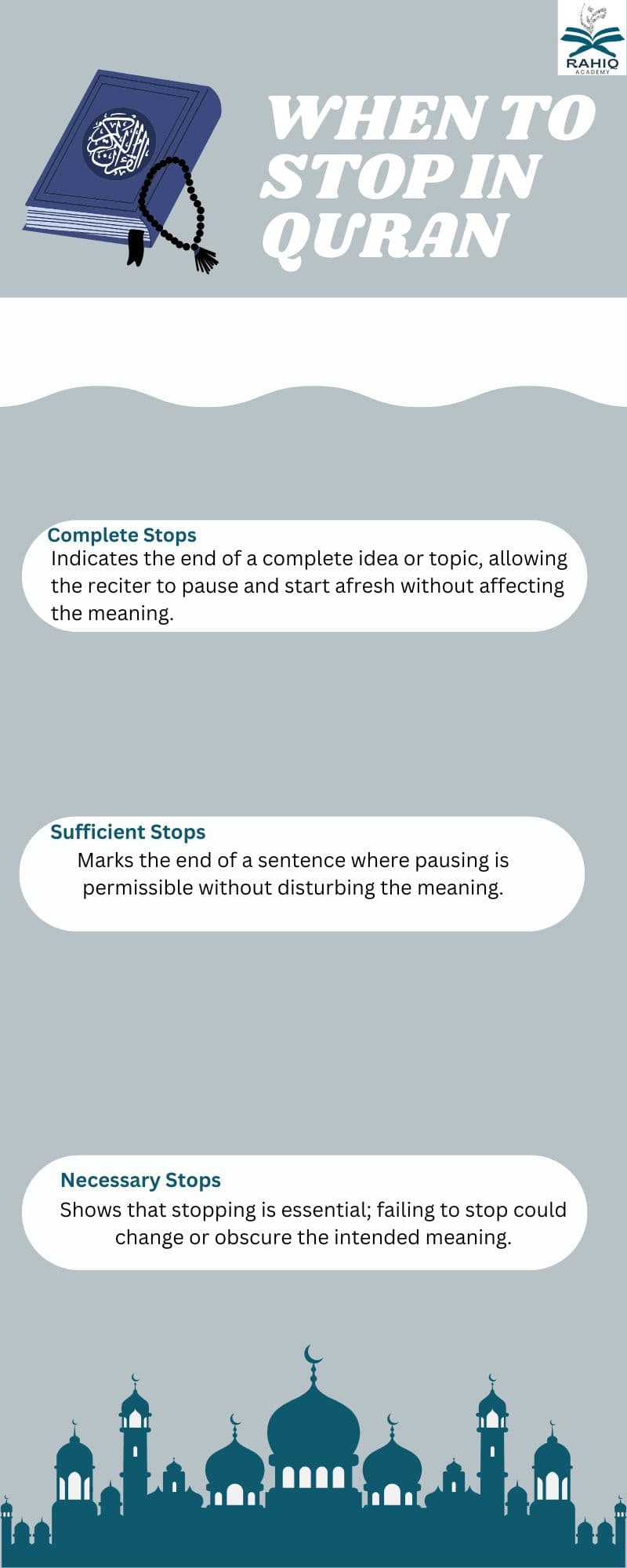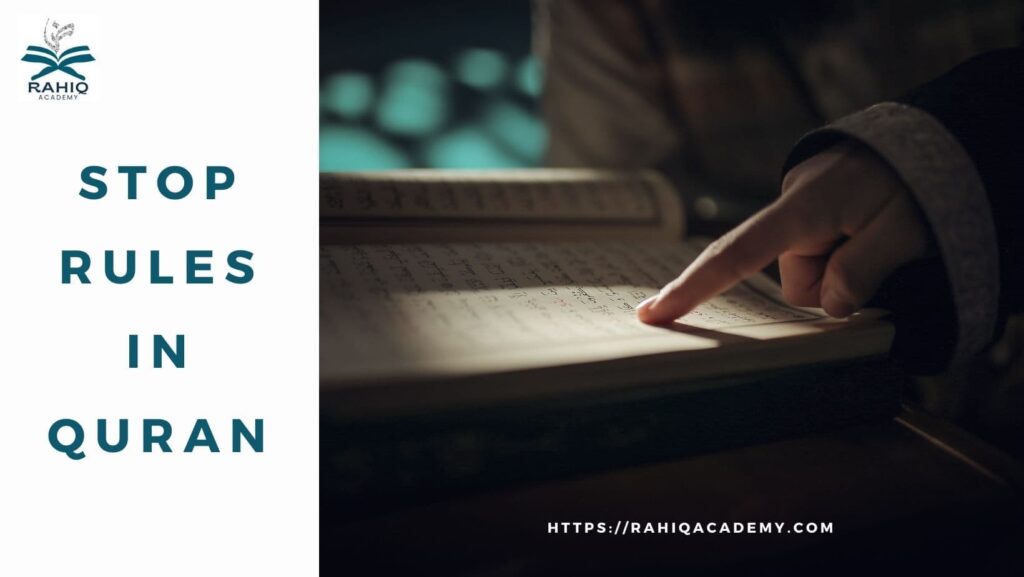The Quran, as the final and eternal guidance for Muslims, was revealed with specific etiquettes and rules for its recitation. Among these rules are the stopping (waqf) and starting rules, which ensure proper pronunciation, comprehension, and respect for the Divine words. This article delves into the essential stop rules in Quran, their importance, and the etiquette of starting again.
When to Stop in Quran

Stopping during Quranic recitation is essential to preserve the meaning and ensure clarity. The Quran includes specific symbols and signs to indicate where one should pause, stop entirely, or avoid stopping. These stopping points serve as guides to uphold the intended meanings of the verses.
Some key points to learn when to stop in Quran:
1-Complete Stops (الوقف التام)
Indicates the end of a complete idea or topic, allowing the reciter to pause and start afresh without affecting the meaning.
2-Sufficient Stops (الوقف الكافي)
Marks the end of a sentence where pausing is permissible without disturbing the meaning.
3-Necessary Stops (الوقف اللازم)
Shows that stopping is essential; failing to stop could change or obscure the intended meaning.
Importance of the Rules of Stopping When Reading Quran
The stopping rules emphasize respect for the Quranic message and ensure its correct delivery. The benefits include:
• Preserving Meaning
Improper stops may lead to misinterpretation of the verses.
• Facilitating Reflection
Stopping appropriately allows the reciter to ponder the meanings of Allah’s words.
• Improving Pronunciation
Adhering to waqf signs enhances Tajweed, the proper articulation of Quranic verses.
Allah says in the Quran:
“وَرَتِّلِ الْقُرْآنَ تَرْتِيلًا”
“And recite the Quran with measured recitation.” (Surah Al-Muzzammil 73:4)
Additional Tools for Dealing with the Stopping Symbols
To master stopping in Quranic recitation, the following tools can be helpful:
Tajweed Classes
Specialized courses teach the proper pronunciation and stopping rules.
Quranic Apps
Apps often feature explanations for stopping symbols and audio demonstrations.
Quranic Teachers
An experienced teacher can guide you in applying the stopping rules effectively.
Quran Symbols Rules
The Quran features various stopping signs to assist the reciter:
- مـ (Mim): Indicates a mandatory stop.
- لا (La): suggests avoiding stopping at this point.
- ط (Taa): Marks a complete stop.
- ج (Jeem): Indicates that stopping is permissible.
Quran Breathless Pause Signs
Quran breathless pauses signs are short stops when the reciter is unable to continue due to a lack of breath. These are usually marked with small symbols like a single dot or a slanted line.
How to Stop While Reading Quran (Stopping on the Ends of Words)
Stopping at the ends of words in the Quran follows specific rules:
•Sukoon (Silent End)
The last letter of the word is pronounced with sukoon (no vowel sound).
•Stretching Rules
In some cases, elongation (madd) is applied to vowels at the end of words before stopping.
Example:
“إِنَّ اللَّهَ غَفُورٌ رَحِيمٌ”
“Indeed, Allah is Forgiving and Merciful.” (Surah Al-Baqarah 2:173)
The Start Rules of Reading Quran
After stopping, it is equally important to follow proper starting rules to ensure continuity and respect for the Quran.
The Allowed Start
- Starting from the Beginning of a Verse: preferred when the verse contains a complete meaning.
- Resuming from the Middle of a Verse: Permitted if it does not distort the meaning.
The Not Allowed Start
- Starting in the Middle of an Incomplete Sentence: May lead to misunderstanding of the verse.
- Resuming at a Point That Changes the Context: Avoid starting in a way that alters the intended meaning of the Quranic message.
Conclusion
Stop Rules in Quran are essential components of proper recitation. They not only enhance understanding but also demonstrate respect for the divine words. By adhering to these rules, Muslims ensure they honor Allah’s guidance and the eloquence of His revelation.
At RAHIQ Academy, we offer specialized Tajweed and Quranic recitation courses that teach these essential rules, helping you perfect your recitation.
Enroll now and receive expert guidance from certified instructors dedicated to enhancing your Quranic journey.
FAQ
Q:Why are stopping rules important in Quran recitation?
A:Stopping rules preserve the meaning of verses, enhance understanding, and improve Tajweed.
Q:What is the symbol for a mandatory stop in the Quran?
A:The symbol مـ (Mim) indicates a mandatory stop.
Q:Can I start reading from the middle of a verse?
A:Yes, but only if it does not distort the meaning of the verse.
Q:Where can I learn Quranic stopping rules?
A:At RAHIQ Academy, we offer comprehensive courses that teach stopping and starting rules with proper Tajweed.




